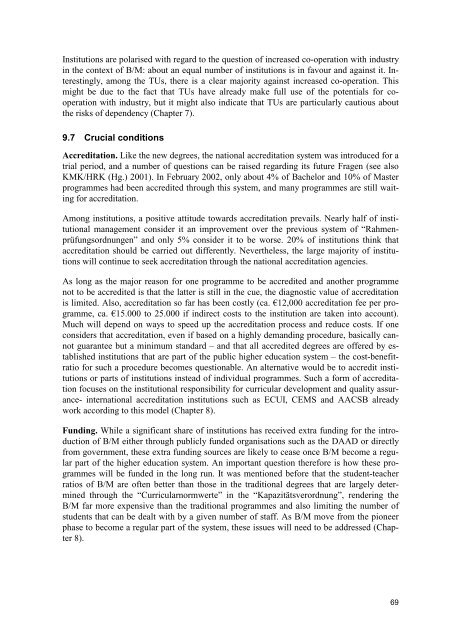and Master Programmes in German Higher Education Institutions
and Master Programmes in German Higher Education Institutions
and Master Programmes in German Higher Education Institutions
- No tags were found...
You also want an ePaper? Increase the reach of your titles
YUMPU automatically turns print PDFs into web optimized ePapers that Google loves.
<strong>Institutions</strong> are polarised with regard to the question of <strong>in</strong>creased co-operation with <strong>in</strong>dustry<strong>in</strong> the context of B/M: about an equal number of <strong>in</strong>stitutions is <strong>in</strong> favour <strong>and</strong> aga<strong>in</strong>st it. Interest<strong>in</strong>gly,among the TUs, there is a clear majority aga<strong>in</strong>st <strong>in</strong>creased co-operation. Thismight be due to the fact that TUs have already make full use of the potentials for cooperationwith <strong>in</strong>dustry, but it might also <strong>in</strong>dicate that TUs are particularly cautious aboutthe risks of dependency (Chapter 7).9.7 Crucial conditionsAccreditation. Like the new degrees, the national accreditation system was <strong>in</strong>troduced for atrial period, <strong>and</strong> a number of questions can be raised regard<strong>in</strong>g its future Fragen (see alsoKMK/HRK (Hg.) 2001). In February 2002, only about 4% of Bachelor <strong>and</strong> 10% of <strong>Master</strong>programmes had been accredited through this system, <strong>and</strong> many programmes are still wait<strong>in</strong>gfor accreditation.Among <strong>in</strong>stitutions, a positive attitude towards accreditation prevails. Nearly half of <strong>in</strong>stitutionalmanagement consider it an improvement over the previous system of “Rahmenprüfungsordnungen”<strong>and</strong> only 5% consider it to be worse. 20% of <strong>in</strong>stitutions th<strong>in</strong>k thataccreditation should be carried out differently. Nevertheless, the large majority of <strong>in</strong>stitutionswill cont<strong>in</strong>ue to seek accreditation through the national accreditation agencies.As long as the major reason for one programme to be accredited <strong>and</strong> another programmenot to be accredited is that the latter is still <strong>in</strong> the cue, the diagnostic value of accreditationis limited. Also, accreditation so far has been costly (ca. €12,000 accreditation fee per programme,ca. €15.000 to 25.000 if <strong>in</strong>direct costs to the <strong>in</strong>stitution are taken <strong>in</strong>to account).Much will depend on ways to speed up the accreditation process <strong>and</strong> reduce costs. If oneconsiders that accreditation, even if based on a highly dem<strong>and</strong><strong>in</strong>g procedure, basically cannotguarantee but a m<strong>in</strong>imum st<strong>and</strong>ard – <strong>and</strong> that all accredited degrees are offered by established<strong>in</strong>stitutions that are part of the public higher education system – the cost-benefitratiofor such a procedure becomes questionable. An alternative would be to accredit <strong>in</strong>stitutionsor parts of <strong>in</strong>stitutions <strong>in</strong>stead of <strong>in</strong>dividual programmes. Such a form of accreditationfocuses on the <strong>in</strong>stitutional responsibility for curricular development <strong>and</strong> quality assurance-<strong>in</strong>ternational accreditation <strong>in</strong>stitutions such as ECUI, CEMS <strong>and</strong> AACSB alreadywork accord<strong>in</strong>g to this model (Chapter 8).Fund<strong>in</strong>g. While a significant share of <strong>in</strong>stitutions has received extra fund<strong>in</strong>g for the <strong>in</strong>troductionof B/M either through publicly funded organisations such as the DAAD or directlyfrom government, these extra fund<strong>in</strong>g sources are likely to cease once B/M become a regularpart of the higher education system. An important question therefore is how these programmeswill be funded <strong>in</strong> the long run. It was mentioned before that the student-teacherratios of B/M are often better than those <strong>in</strong> the traditional degrees that are largely determ<strong>in</strong>edthrough the “Curricularnormwerte” <strong>in</strong> the “Kapazitätsverordnung”, render<strong>in</strong>g theB/M far more expensive than the traditional programmes <strong>and</strong> also limit<strong>in</strong>g the number ofstudents that can be dealt with by a given number of staff. As B/M move from the pioneerphase to become a regular part of the system, these issues will need to be addressed (Chapter8).69
















